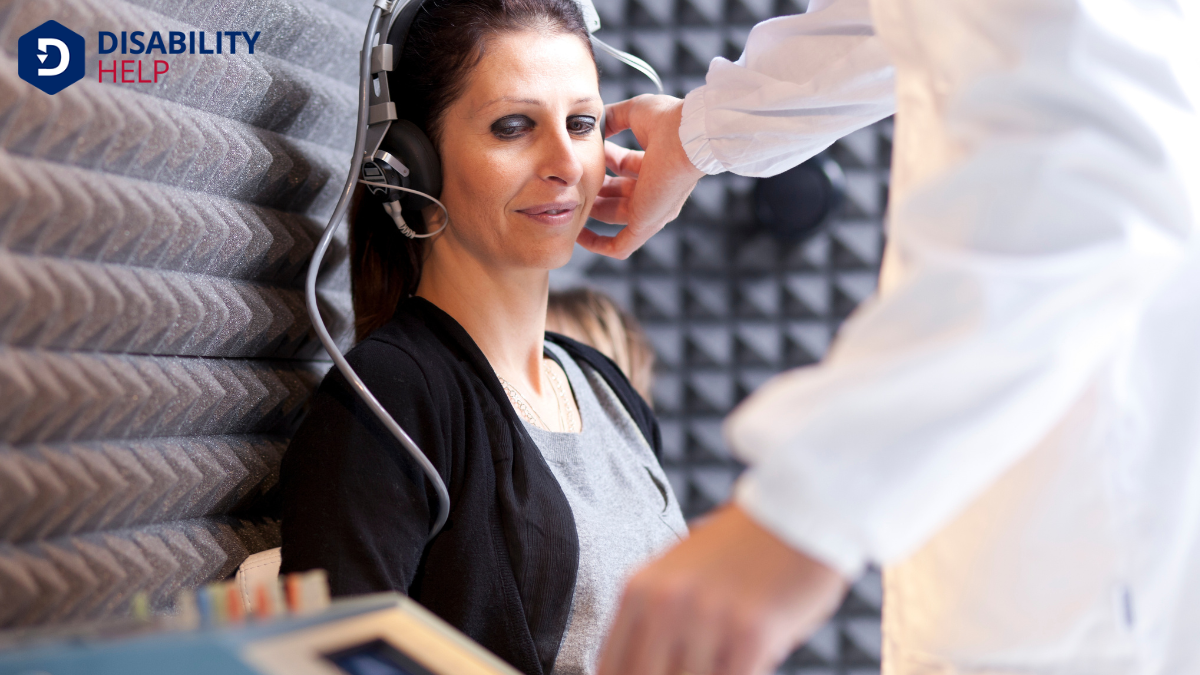Let's explore the fascinating world of assistive technologies for hearing impairmentA loss or abnormality of a body structure or function, whether physical, mental, or sensory, often a.... From hearing aids to cochlear implants and bone conduction devices, there's a variety of solutions tailored to enhance auditory experiences. We've seen incredible advancements in smart hearing aids and smartphone apps that personalize sound amplification. But how do these technologies truly transform communication and engagement for those with hearing challenges? There's much more to uncover about these innovative aids.
Key Takeaways
- Hearing aids amplify sound and improve clarity for individuals with hearing impairments.
- Cochlear implants provide sound perception by directly stimulating the auditory nerve for severe sensorineural hearing lossPartial or total inability to hear sounds in one or both ears..
- Bone conduction devices transmit sound vibrations through the skull, aiding those with conductive hearing loss.
- Smartphone apps offer real-time sound amplification and customizable hearing profiles.
- Smart hearing aids use AI to adaptA grassroots disability rights organization in the U.S. that focuses on promoting community-based se... automatically to different sound environments, enhancing user experience.
Understanding Hearing Aids
When it comes to understanding hearing aids, they play an essential role in enhancing the quality of life for individuals with hearing impairments. We often find that hearing aids amplify sound, making it easier for users to engage with their environment.
These devices come in various styles, such as behind-the-ear, in-the-ear, and completely-in-canal, catering to different needs and preferences.
It's important for us to recognize that hearing aids don’t restore hearing to normal but greatly improve sound clarity. They help us connect with loved ones, enjoy music, and participate in conversations more fully.
When selecting a hearing aid, consulting with an audiologist guarantees we choose the right device that suits our specific hearing loss and lifestyle. Understanding these devices empowers us to make informed decisions.
Exploring Cochlear Implants

Although hearing aids are invaluable, they mightn't be suitable for everyone with profound hearing loss. That's where cochlear implants come in. These devices can provide a sense of sound to those who can't benefit from traditional hearing aids. Cochlear implants bypass damaged parts of the ear and directly stimulate the auditory nerve.
We've found that cochlear implants are most effective for individuals with severe to profound sensorineural hearing loss. The implant consists of two main components: an external processor and an internal implant. The external processor captures sound, processes it, and sends the signals to the internal implant. The implant then converts these signals into electrical impulses that the brain interprets as sound.
Cochlear implants require surgical implantation and specialized therapy for ideal outcomes.
The Role of Bone Conduction Devices
After exploring cochlear implants, let's consider another innovative solution for hearing impairment: bone conduction devices.
These devices bypass the outer and middle ear by transmitting sound vibrations directly through the skull to the inner ear. It's a fascinating concept, isn't it? For individuals with conductive hearing loss or single-sided deafnessSignificant hearing loss that affects the ability to communicate or perceive sounds., bone conduction can be incredibly effective.
We're looking at a technology that offers an alternative for those who can't benefit from traditional hearing aids. Bone conduction devices can be worn like a headband or implanted surgically.
While they don’t amplify sounds like hearing aids, they provide clarity by directly stimulating the cochlea. We should appreciate this technology as it opens doors for those who might otherwise struggle with conventional options.
Advancements in Hearing Assistive Technology
Despite the challenges faced by those with hearing impairments, advancements in hearing assistive technology have transformed how individuals interact with the world around them.
We've seen remarkable progress in devices that amplify sound, making it easier for people to engage in conversations and enjoy music or television. Digital hearing aids, for instance, now offer customizable settings, allowing users to adapt to different environments effortlessly.
Moreover, cochlear implants continue to evolve, offering improved sound quality and better integration with external devices. This means clearer audio experiences for users.
Loop systems, which work with T-coil-equipped hearing aids, also enhance sound clarity in public spaces. As technology progresses, we can expect even more innovative solutions, creating a more inclusive world for everyone with hearing challenges.
Smartphone Apps for Hearing Improvement

Let's explore how smartphone apps are enhancing our hearing experiences.
These apps offer real-time sound amplification, allowing us to better engage with our surroundings.
Additionally, customizable hearing profiles let us tailor sound settings to our unique needs, ensuring a more personalized hearing experience.
Real-Time Sound Amplification
When it comes to enhancing auditory experiences for those with hearing impairments, real-time sound amplification via smartphone apps is a game-changer.
These apps transform our phones into personal sound amplifiers, capturing surrounding sounds and delivering them directly to our ears through headphones. This technology empowers us to engage more fully in conversations and enjoy clearer audio in various environments.
Many of these apps feature user-friendly interfaces, making them accessible to everyone, regardless of tech-savviness.
We can adjust the volume and frequency levels in real-time, allowing us to customize the sound to our immediate needs. This flexibility guarantees that we’re not missing out on important moments, whether in a bustling café or a quiet office.
With these tools, hearing becomes a more inclusive experience.
Customizable Hearing Profiles
As technology advances, we're seeing remarkable improvements in smartphone apps designed to enhance hearing by offering customizable hearing profiles. These profiles allow us to tailor sound settings to meet our individual needs, ensuring we hear more clearly in various environments.
By using our phone's microphone, these apps can analyze ambient sounds and adjust frequencies that we might struggle with.
It's empowering to have control over our hearing experience. We can adjust for noisy restaurants, quiet conversations, or even outdoor activities. With a few taps, we can switch between profiles, making it easier to adapt to different situations.
These apps often provide hearing tests, helping us fine-tune our settings. Let’s embrace this technology to improve our hearing and enhance our daily interactions.
Utilizing FM Systems for Better Hearing
How can we enhance the auditory experience for those with hearing impairments? FM systems offer a powerful solution. By using radio waves, FM systems transmit sound directly from a source, like a microphone, to a receiver worn by the listener.
This technology is especially useful in environments with background noise or when the speaker is at a distance. We can consider it an assistive bridge between speaker and listener, ensuring clarity and reducing effort in understanding speech.
FM systems are versatile, working well in classrooms, meetings, or public spaces. They can be used with hearing aids or cochlear implants, providing a seamless auditory experience.
Captioning Services and Devices
While FM systems facilitate a direct auditory connection, captioning services and devices open up a world of visual accessibilityThe design of products, devices, services, or environments to be usable by people with disabilities.... for those with hearing impairments. These tools transform spoken words into text, making information more accessible in various settings.
We can see this in action through closed captioning on TV, live captioning at events, and video conferencing apps that provide real-time text. Subtitles for streaming services guarantee that we don’t miss a single plot twist, while specialized devices like captioned phones allow us to read conversations clearly.
With speech-to-text apps on our smartphones, we’re always equipped to capture verbal exchanges anytime, anywhere. By integrating these technologies into our daily lives, we’re making strides toward a more inclusive world for everyone.
Emerging Technologies in Hearing Assistance

Though we've made significant advancements, the field of hearing assistance continues to evolve with exciting new technologies.
We're seeing incredible innovations that promise to enhance the hearing experience more than ever before. For instance, augmented reality (AR) glasses can now display real-time captions during conversations, offering a seamless way for those with hearing impairments to follow along.
Additionally, advancements in artificial intelligence have led to smarter hearing aids that can adapt to different sound environments automatically, providing clearer audio without manual adjustments.
Moreover, brain-computer interfaces are being explored to bypass damaged auditory pathways, potentially restoring hearing by directly stimulating the brain.
These cutting-edge solutions aren't just theoretical; they're actively being developed and tested, promising a brighter, more connected future for everyone.
Conclusion
In exploring the diverse assistive technologies for hearing impairment, we've seen how hearing aids, cochlear implants, and bone conduction devices each offer unique benefits. Advancements like smart hearing aids and smartphone apps personalize these experiences, making communication easier. Let's not forget FM systems and captioning services, which further enhance our ability to engage with the world around us. As emerging technologies continue to evolve, we’re excited about the future possibilities in hearing assistance.






